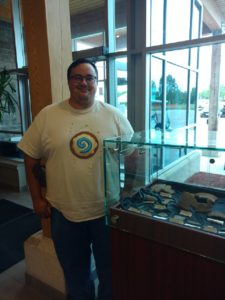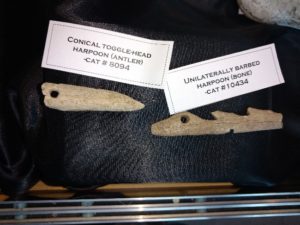Aamjiwnaang First Nation to display ancestral heritage artifacts this summer

By Colin Graf
AAMJIWNAANG FIRST NATION—Members of Aamjiwnaang First Nation have a unique opportunity this summer to see pieces of their ancient heritage, found in the 1990s excavation for the twinning of the Blue Water Bridge from nearby Sarnia to Port Huron, Michigan.
Visitors to the community centre can view 2 glass cases full of objects such as arrowheads, sections of pottery bowls, bone harpoons, and carved birdstones used in the daily lives of their ancestors dating back up to 1,000 years.
The artifacts are on loan from the government for three months, according to newly-elected councillor Marina Plain, head of E’Maawizidjig, the Aamjiwnaang Heritage & Culture group.
Plain adds that the temporary return of the objects came about after the group contacted the Ontario Ministry of Culture, Tourism and Sport and arranged to view some of the artifacts at a Ministry warehouse in London, Ontario last year.
The group told officials that their wish was to eventually have the artifacts returned permanently to Aamjiwnaang; however, Plain feels that without a museum or heritage centre, that goal is still far off.
Discoveries made at the two adjacent sites show that they are part of a larger ancient Indigenous landscape spread out along the St. Clair River where it meets Lake Huron and may represent “one of the largest and richest artifact sites in Ontario,” according to Shari Prowse, Archaeology Review Officer with the Ministry.
Prowse, who worked on the bridge dig as a university student in the ‘90s, states that there are roughly a million artifacts from the bridge digs currently in the care of the ministry, including stone and bone tools, pottery fragments, animal and plant remains. The collection is being kept in approximately 50 boxes which also contain field notes, maps, and excavation records.
“[Working at the site was] like opening a time capsule to the past,” Prowse remembers. “The collection will help researchers understand many things about the way of life of the people who lived there for thousands of years.”
The deposits were well preserved, representing thousands of years of occupations in the area.

Evidence shows in ancient times, Indigenous peoples not only lived at the meeting of the waterways, but also played host to large gatherings, with various groups travelling from across a wide area of Turtle Island. When the groups gathered, one thing that’s certain is that their diet included lots of fish. Prowse has analyzed over 200,000 fish remains and other fishing-related artifacts such as hooks, harpoons and gorges, to prove the importance of fishing at the site, as part of her Master’s thesis work in the late 1990’s at the University of Western Ontario.
Around the years 200-600 AD, Indigenous groups would start net fishing in the early spring for both walleye and freshwater drum with the spawning runs of the walleye and would finish in July with the end of the spawning runs of the drum, she detailed in a 2003 scholarly article.
The seine nets were probably set across one or more of the river channels that existed back then, now replaced by the St. Clair River, and drawn close to shore where the fish could be speared or plucked by hand as they splashed around in the shallows, Prowse wrote.
Having the artifacts at the centre is especially meaningful for Winterson Rogers, who worked on the dig as a student from Aamjiwnaang for two seasons. Helping to interpret the artifacts for visitors, Rogers remembers when his crew found a piece of worked obsidian, a kind of volcanic glass. Rogers adds that since the only source for that glass is from the western United States, that find proved that the area of the dig was a major meeting place for Indigenous peoples from across the continent.
Rogers recalls that another memorable moment was uncovering bones of ancestors in what was clearly an ancient burial ground. The bones that were bundled together in the ancient form of burial, were re-buried with proper ceremonies and the help of Aamjiwnaang Elders at the time.
“To uncover these remains and work with the bones of our ancestors was a truly spiritual experience,” describes Rogers when reflecting upon his feelings at the time of the uncovering.
Working on the site of the present-day duty-free store at the foot of the Blue Water Bridge, the archaeologists charted out the size and dimensions of the Indigenous village there. According to Rogers, they could tell where fire pits had been located, and could trace the location of postholes by the brown circles they had left in the red sand.
“Realizing how everyday necessities were major undertakings for ancestors has caused him to think long and hard about appreciating everything we have today,” he says.
Acting as an unofficial guide to the artifacts at the community centre, Rogers finds Aamjiwnaang members are in awe and impressed with the ancient technology.
“These may be primitive tools, but they got the job done,” noted Rogers.
While Aamjiwnaang has shown interest in the archaeological collection being accessible to the community, there are no formal plans for more artifacts to be displayed, according to Prowse. However, the ministry would welcome the opportunity to work with the community on projects that may involve the loan of artifacts, she says.
Archaeological collections can be loaned for display, ceremonial, and research purposes when they can be appropriately cared for while away from the government’s care, and similar “loan agreements” with other Indigenous communities are in place in Ontario, she adds.


